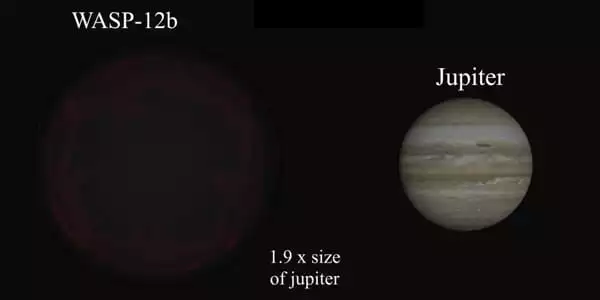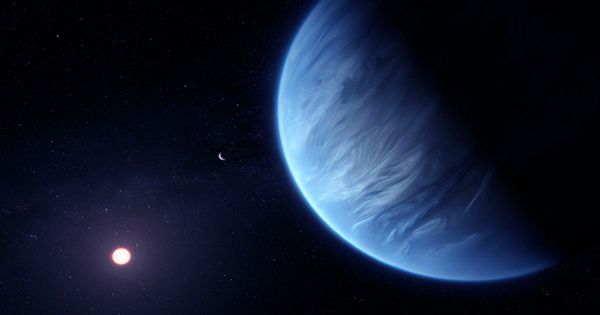The doomed planet WASP-12b is a hot Jupiter that is being torn apart by its parent star. It is a hot Jupiter (a type of extrasolar planet) that orbits the star WASP-12 and was discovered by the SuperWASP planetary transit survey on April 1, 2008. This alien world completes its orbit around its sun in only 1.1 days. In comparison to the Earth’s 365-day orbit around the Sun, the planet takes just over one Earth day to orbit its star.
Its distance from the star (approximately 2.115 million miles (3.404 million kilometers; 0.02275 astronomical units) is only 1/44 that of the Earth, and it has the same eccentricity as Jupiter. The scorching heat of the star is slowly eroding and devouring the planet’s atmosphere. This alien world could be completely consumed in 10 million years.
WASP-12b is a bloated gas giant that transits its Sun-like star every 1.1 days from a distance of only 0.02 astronomical units (a.u. ), or about nine times the distance between Earth and the moon. As a result, it has one of the lowest exoplanet densities (“inflated” by the flux of energy from the star). On December 3, 2013, scientists using the Hubble Space Telescope (HST) reported finding water in the exoplanet’s atmosphere. NASA announced in July 2014 the discovery of very dry atmospheres on three exoplanets (HD 189733b, HD 209458b, and WASP-12b) orbiting sun-like stars.
Researchers working on the HST announced in September 2017 that WASP-12b absorbs, rather than reflects, at least 94 percent of the light that shines on its surface. As a result, the exoplanet has been called “black as asphalt” and “pitch black.”

Characteristics
WASP-12b is a sizzling gas giant nearly twice the size of our Jupiter, with a temperature of around 4,000 degrees Fahrenheit (2,210 degrees Celsius). Because hot Jupiter exoplanets are “phase-locked” by tidal interactions (that is, the same side always faces the host star, just as our moon always faces us), there is a large flow of heat from the highly irradiated “day side” to the cooler “night side.” This is thought to cause extremely strong winds to rush around the planet’s atmosphere.
Taylor Bell and Nicolas Cowan have observed that hydrogen tends to ionize on the dayside. After flowing to the cooler face of wind, it will tend to recombine into neutral atoms, enhancing heat transport.
Because the planet is so close to its star, tidal forces are distorting it into an egg shape and sucking away its atmosphere at a rate of about 107 MJ (about 189 quadrillion tons) per year. The combination of “tidal heating” and the planet’s proximity to its star raises the surface temperature to more than 2,500 K (2,200 °C).
The Hubble Space Telescope observed WASP-12b being “consumed” by its star on May 20, 2010. Scientists had known for a long time that stars could consume planets, but this was the first time such an event had been witnessed so clearly. According to NASA, the planet has 10 million years left to live.
Scientists believe that the planet’s core may be solid, with diamond far more abundant than the silicon and other oxygen-rich materials found in Earth’s core, due to the high concentration of carbon in its atmosphere (which is primarily composed of carbon monoxide and methane). “The high carbon-to-oxygen ratio indicates a carbide or diamond interior rather than the Earth’s silicate geology,” said Princeton astrophysicist Nikku Madhusudhan.
















